Visiting Djibouti, the first African country on the Horn of Africa Tour and discovering its unknown natural beauty and strategic importance.
Stepping out of the plane in Djibouti the first thing I noticed was the extreme heat and humidity. Sweat almost immediately started forming on my brow.
Entering the airport is the immigration check. Chris and I were planning on getting a tourist visa on arrival. We had no idea that this was out of the ordinary. Apparently tourists don’t come to Djibouti, so the authorities are baffled when a tourist shows up.
We were questioned as to why we would visit the country, what our professions were and if we were military. A confused man with glasses held our passports and strolled from office to office chatting with other officers and making calls to supervisors. An Italian soldier and what seemed like a group of Ukrainian mercenaries were processed, leaving us as the last two.
Eventually the officer giving stamps questioned us and we were told we needed to wait for a superior officer who was currently busy with a departure. So they brought us up to the empty departure lounge and told us to wait. They explained our luggage will be thoroughly searched. “Not a problem!”
At the adjacent departure gate, we saw over a hundred US soldiers packed in a room waiting for their flight. That’s when we noticed Camp Lemonnier, the only permanent US base in Africa, right across the runway. With its strategic location at the entrance of the shipping lane of the Red Sea, Djibouti has bases for several countries including the US, France, and Spain.
Later the English speaking officer came back up and chatted with us about the sites to see in the country. During an awkward silence he told us to sit tight. At this point, I wondered if the officers were waiting for a bribe or some tip. I mean, it isn’t every day that tourists come to Djibouti!
Fortunately minutes later the man returned and told us we could get our visa.
After a two hour ordeal, we paid USD60 and got our shiny new visas and entry stamps.
Our visit was based out of the Kempinski Djibouti which was an impressive luxury oasis in an otherwise poor city.
One of my urgent objectives was to obtain visas for Eritrea, Sudan, and South Sudan. As the embassy area was near the hotel, we walked over and started at the Eritrea Embassy. A rotund lady with a headless explained that the visa would take up to a month and that’s if the head office bothers to respond. “They don’t even reply to me…” she admitted. I found out later this could be due to political tensions between the countries, but why would they forsaken their own embassy? I got the phone number and would try back.
In the Sudan Embassy I managed to convince the receptionist to take my application and visa expense (10,000 Djibouti Francs) without a letter of invitation. I understood that I could pick up my visa the next day. Excellent.
South Sudan did not have an embassy here.
After that we were off to visit some of the sights of Djibouti.
Our first stop was the Grand Marche de Riyad which was very local and messy. They had a fruit, meat, and clothing market. Unfortunately, no tourist shirts and people did not appreciate photographs. Though a large market, it wasn’t too impressive.
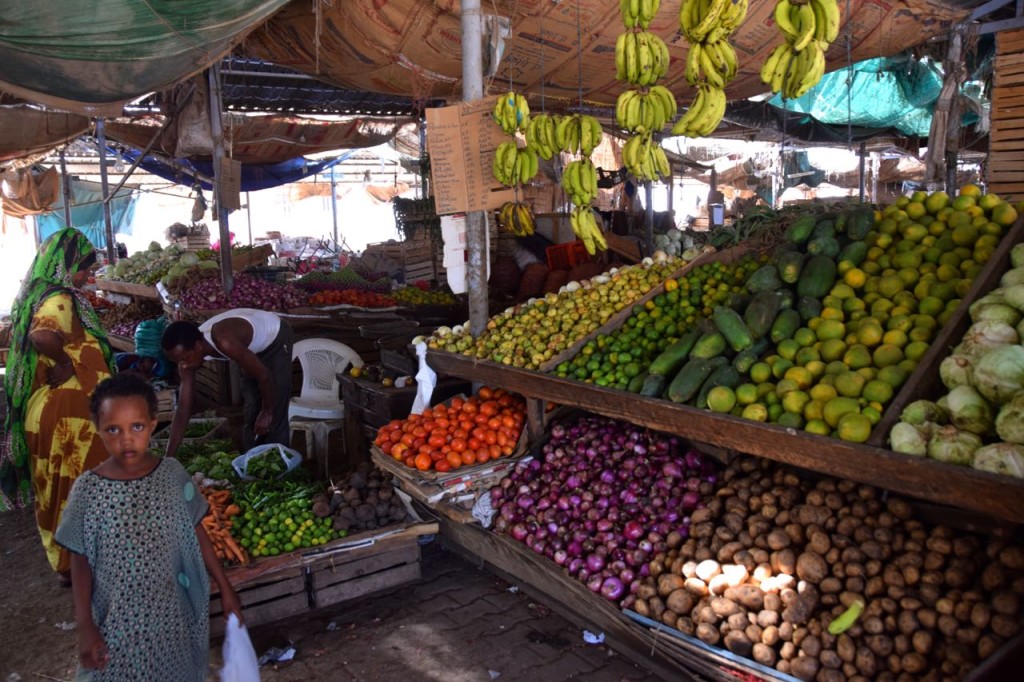
Back in the city center, we started at the tourism office which seemed abandoned and asked about museums to see. “There are none” the receptionist said with a toothy grin. Though not as helpful as we had hoped, she did give us a list of tour companies that could take us to Lac Assal.
We stopped by several tour offices to figure out how to get to Hargeisa, the capital of Somaliland. After comparing costs and convenience, we decided on a one hour Jubba flight for USD150 versus a 12 hour bumpy Land Cruiser journey for about USD60. So we headed to the Jubba Airlines office, a local Djibouti airline not known for their reliability.
In the office ladies speaking English advised that they could sell us a one-way ticket if we could show a flight leaving Somaliland and a Somaliland visa. New objectives added to the list.
The small market across from the tourism office had souvenirs, so I picked up my tourist shirt before walking down to the main square. A mosque sits in the center of this chaotic square with a bustling market on one side and a tangled mess of buses and tuk tuks on the other.
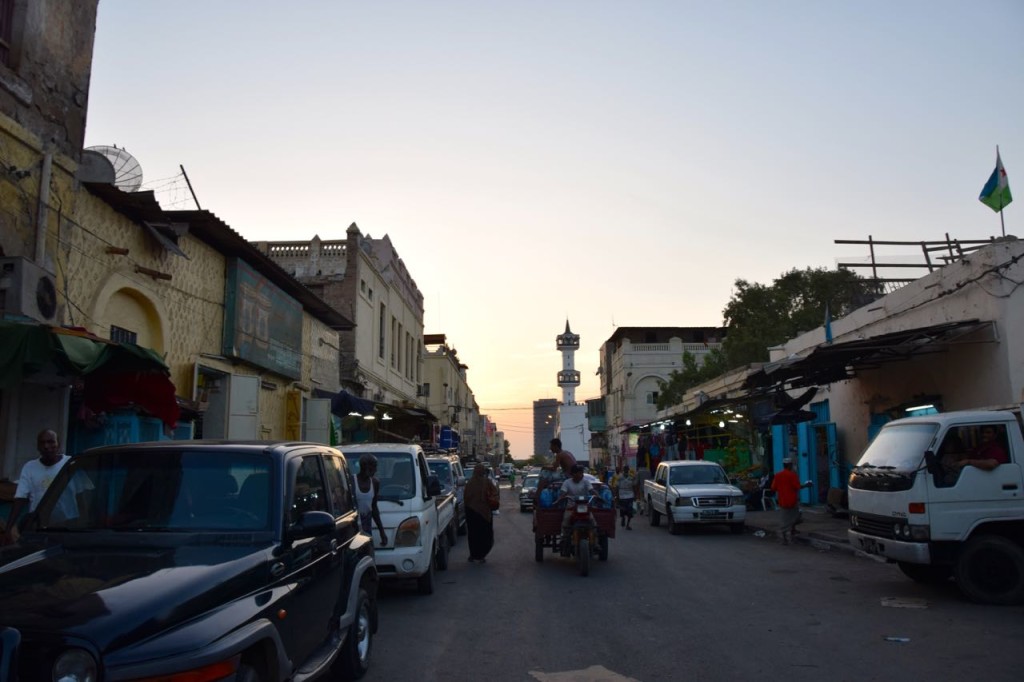
Two guys latched onto us and started following us around as if we paid them to be guides. It was surprisingly difficult to shake them as they would follow us to every shop or restaurant and wait for us to emerge, each time asking for a tip for the help that we never requested.
For dinner we found a tiny restaurant with an active prayer area, selling kebab sandwiches. As the only foreigners in this hole in the wall, we watched the locals pray in the next room as diners watched us eating our delicious chicken sandwiches.
The next morning we got up and called several places to get a tour. We decided on one for 35,000 Djibouti Francs (about USD200) with a group referred to us from the tourism office.
Two friendly guys arrived soon after and we met them in the lobby. After confirming pricing and the tour details, we got in their Land Cruiser and started on our way.
We made a detour to drop off our passports at the Somaliland representative office which was actually the most professional and friendly of all the embassies we visited. Not only would they process it the next day, but they accepted our application missing a passport photo (which we’d bring on pick up) and even gave us tips as to hotels and places to visit in their state.
Lac Assal Tour
The drive was bumpy at some points especially toward the end but a lot of it was on paved roads, mostly constructed by the Chinese. As Ethiopia’s main shipping ports are in Djibouti, hundreds of trucks use these roads for transportation. On route we saw several accidents including containers that seemed to have tumbled off trucks and were left there to rot. A new rail line connecting Addis Ababa and the ports of Djibouti is currently under construction also by the Chinese. I admired the rows of brand-new bright green trains.
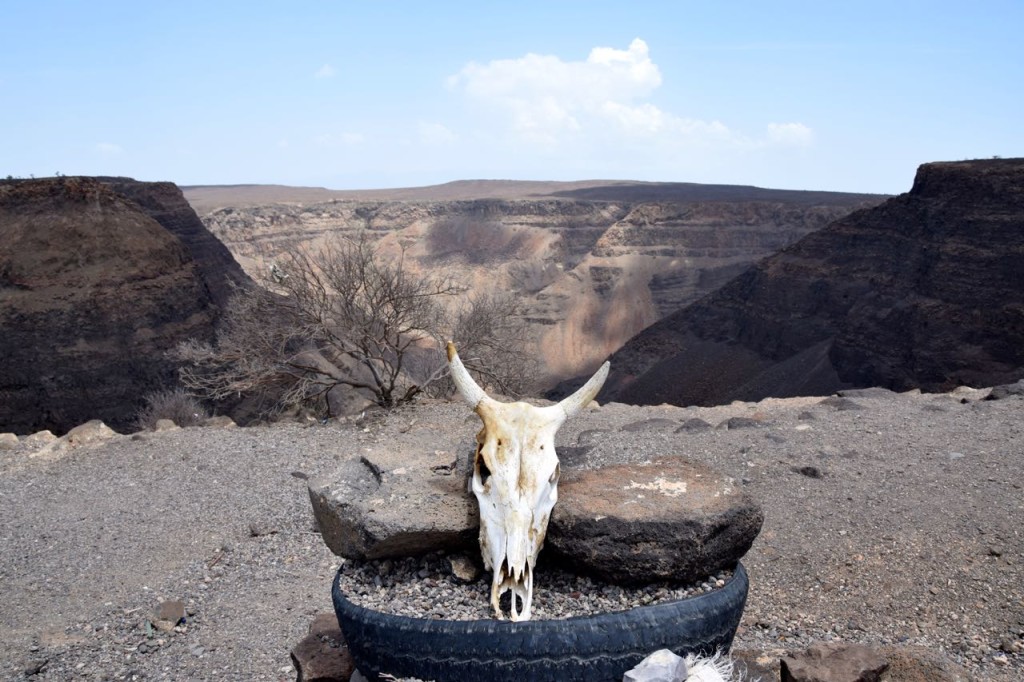
The “Mini Grand Canyon” was one of the few stops we made. This canyon is formed from a rift where the tectonic plates of Africa, Europe and Asia meet. Guys sold gems stones from Afar and handicrafts. We gave two of the sellers a ride to the next town.
Near Lac Assal is a hot spring a short walk from the road. The temperature was really high and I couldn’t keep my fingers in the water. The water that seeps out of the steaming mountain face feeds into Lac Assal.
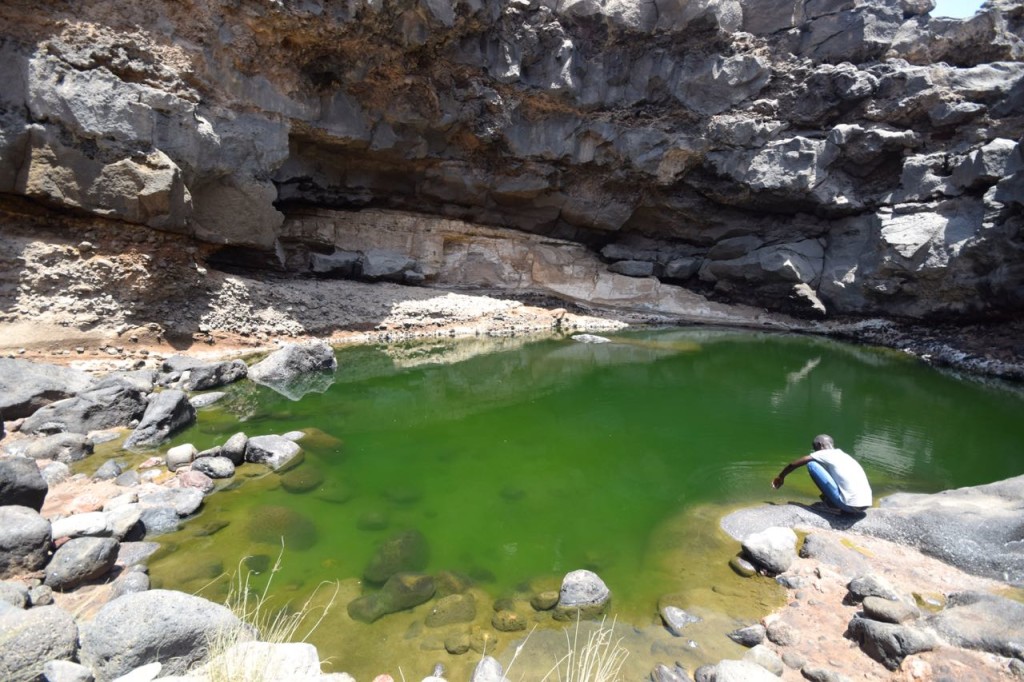
Finally we arrived at the lake and changed into our swim trunks. Having already reached the highest point in Africa, I was now at the lowest point. The water is even saltier than the Dead Sea and the air started to make my eyes burn. The area was deserted. Even souvenir tables were unmanned.
I took off my shoes and walked out onto the jagged salt shore. The lake was shallow and we had to walk quite far before we could “swim”. After floating on the top of the water for ten minutes, every pore and orifice started hurting. Just imagine pouring salt over your body and leaving it there to absorb.
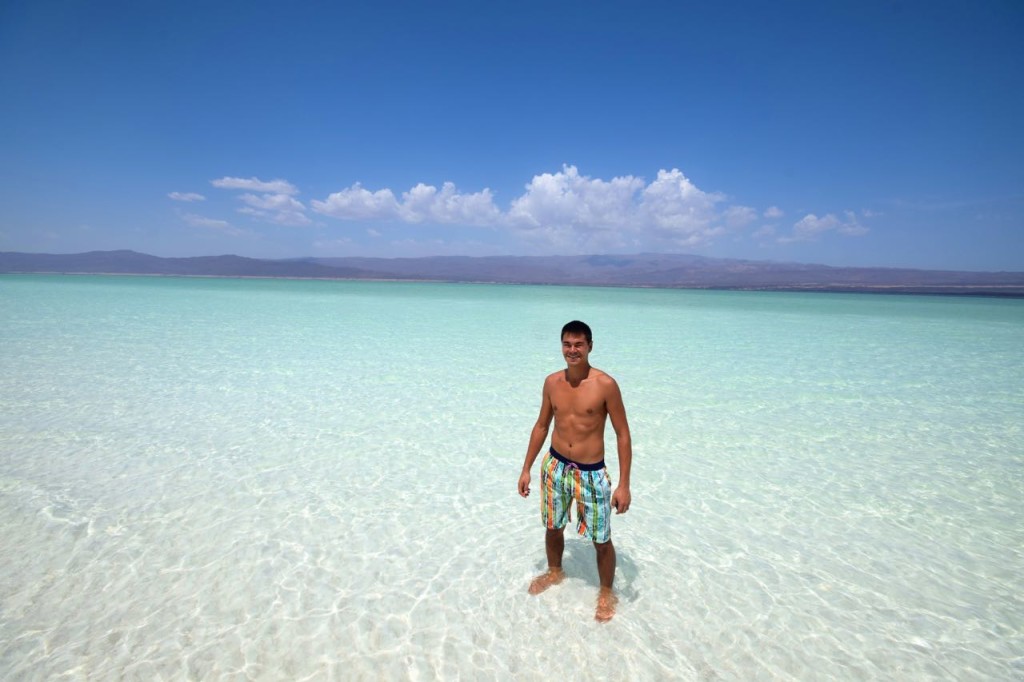
By the time we walked back to the car the salt water crystallized in our hair and on our skin.
We gave a villager a ride back to his town and made a stop to see how the inside of the huts and stores looked. The villager enthusiastically showed us his house and how it was made. Children from all over the village crowded around us out of curiosity. It was refreshing to see the joy of the children even in such a basic environment.
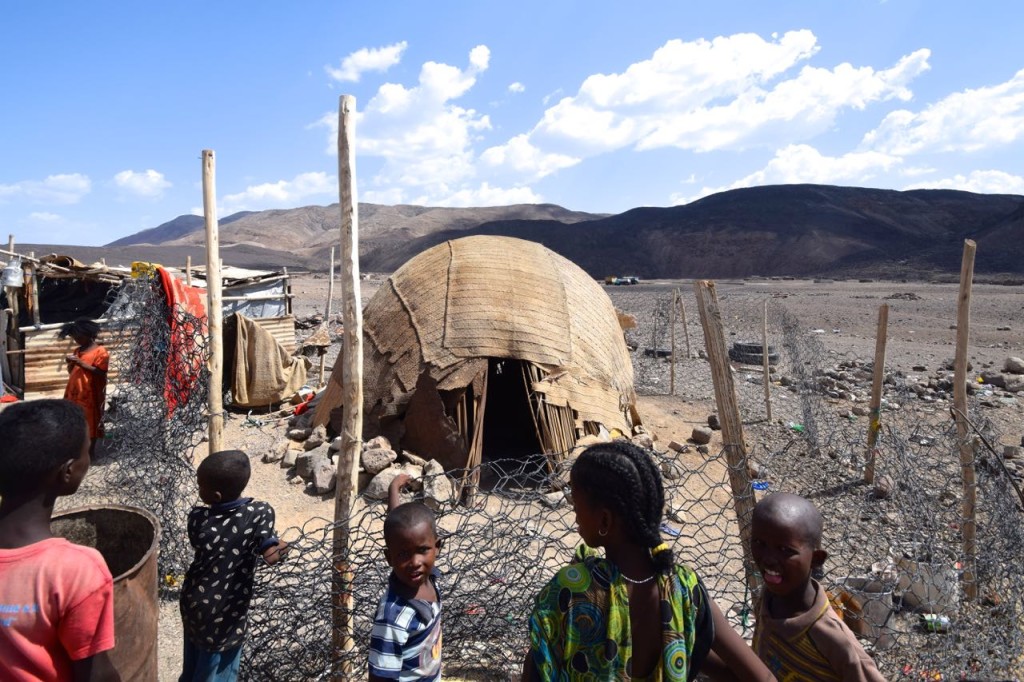
Back in town, we stopped by the Jubba Airlines office to purchase our tickets.
That evening, we relaxed by the Kempinski pool with a Tusker beer while watching the massive container ships light up the horizon. We even went for a swim in the Red Sea, though the amount of algae made it unpleasant.
For dinner, we walked over to the Melting Pot restaurant, known for its relaxed garden dining and camel meat options. Of course I ordered camel tibs and rice. Tony, the owner, is a local Djiboutian of French descent was very welcoming.
The next morning we went to pick up our visas from the Somaliland office and the Sudan embassy. The Somaliland visa (USD31) was straightforward as expected. The Sudan one… not so much. When I arrived I was told the embassy was closed because of a power issue. I said I needed my passport which was inside and that I was flying out in a few hours. The guards at the gate did not understand and were not helpful. Eventually a man who spoke english emerged and helped translate. He suggested I call the embassy number and speak with the secretary. The secretary explained I could come back in a few hours and my passport will be there (without a visa). Apparently I was suppose to have an interview which would have been helpful if they had informed me.
At the airport, we got our boarding passes and went through security. We were three hours early as Jubba Airlines advised which really was a waste of time. We chatted with a Somali-American going back to visit family after 25 years. Soon the room filled with American soldiers about to head home after their tour. There must have been around 150 of them squeezed in the room and occupying all the floor space. They ate, played on their phones, watched movies on their MacBooks, gambled, or slept. They weren’t very talkative either which could be a policy that I’m unaware of.
Boarding the Jubba A320, I noticed that the staff and empty plane were branded Yan Airlines, a Ukrainian company that must have been contracted by the local airline.
Buckled-in we were on our way to Hargeisa!
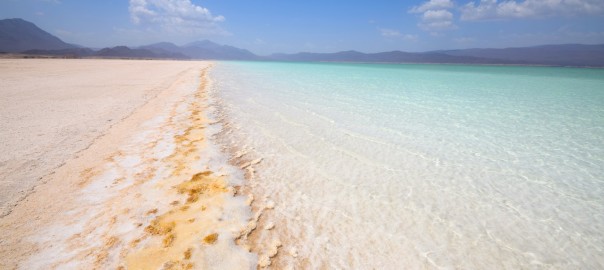
Pingback: 2015 Year Review | World-Adventurer()